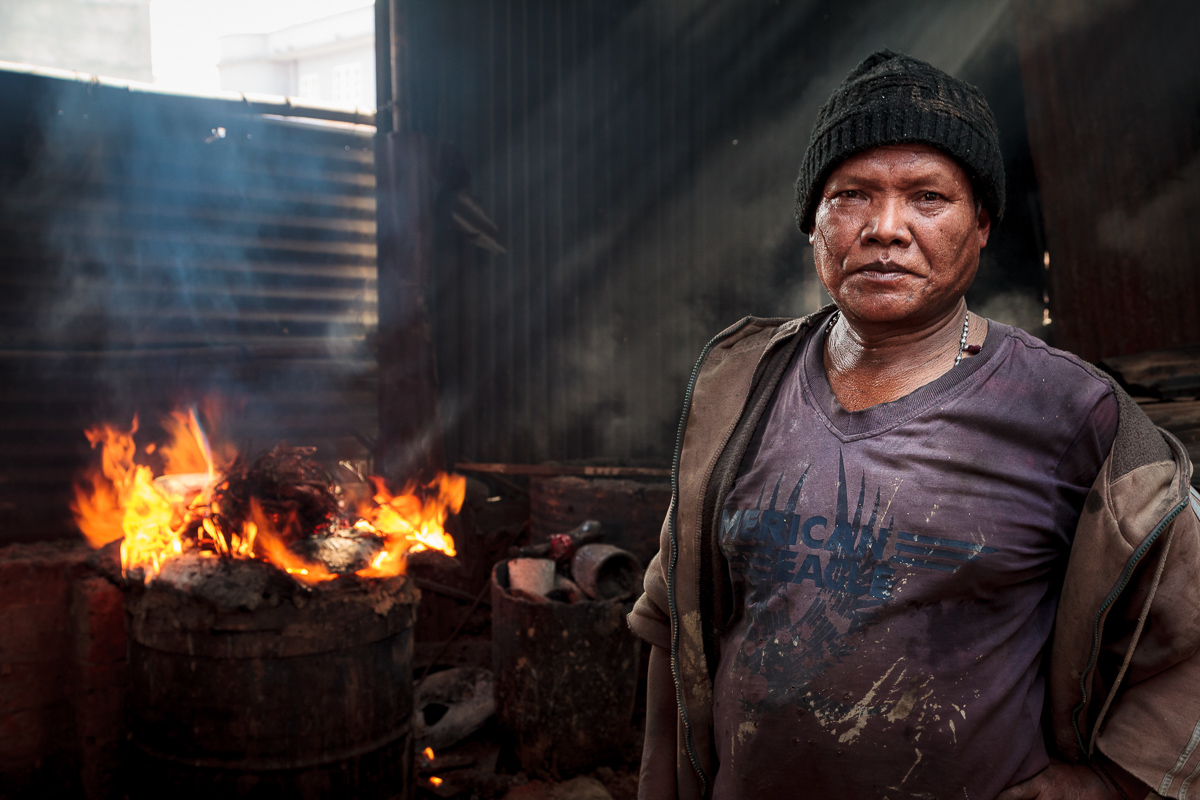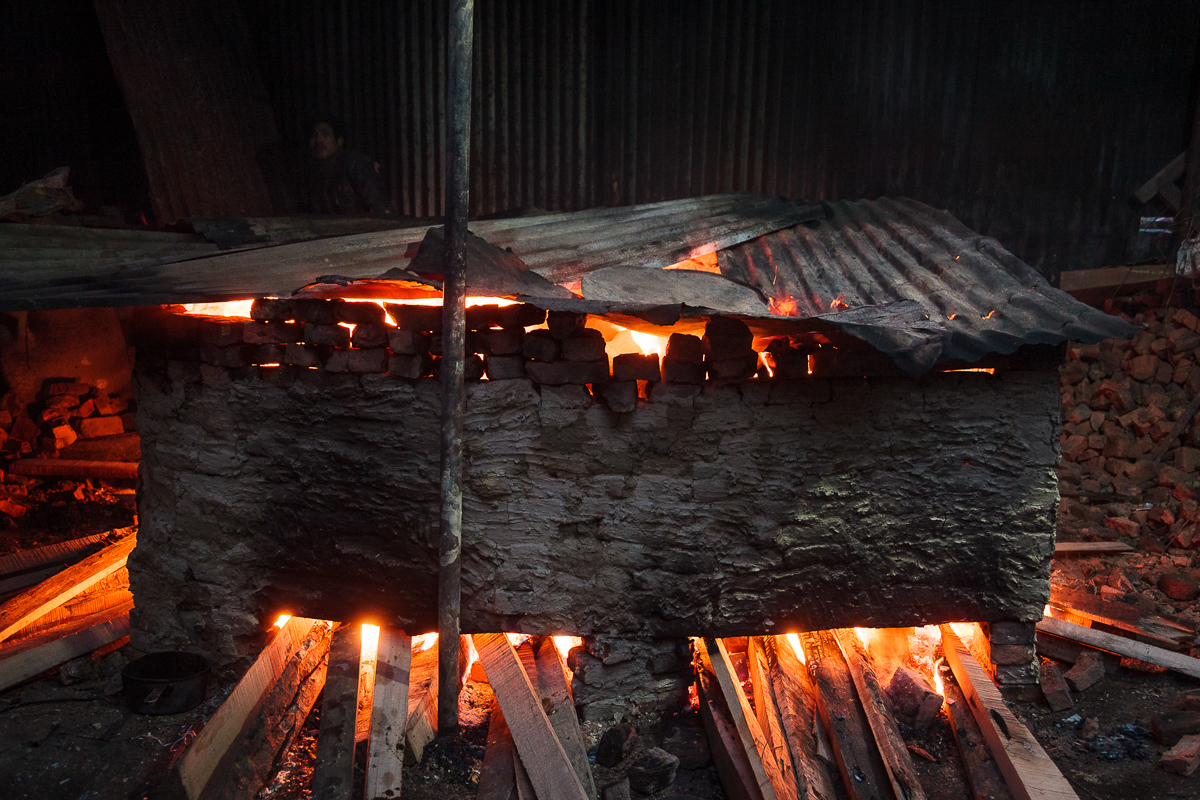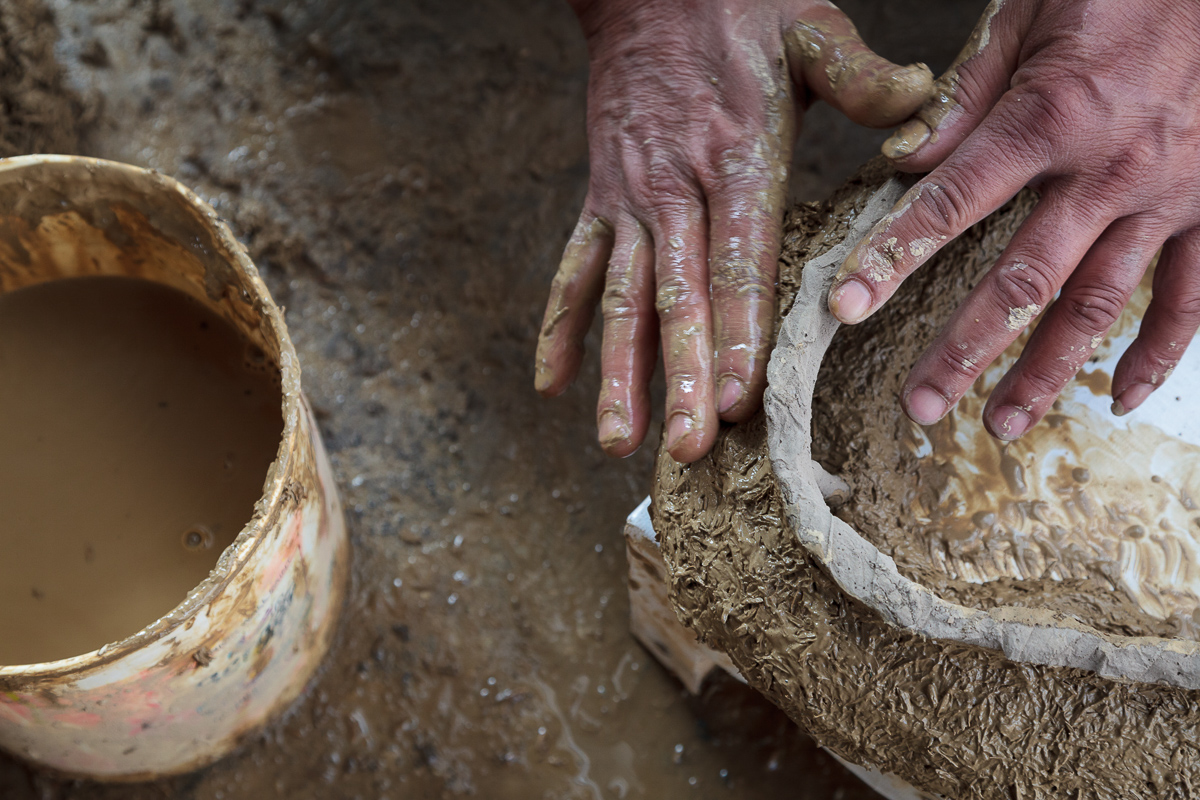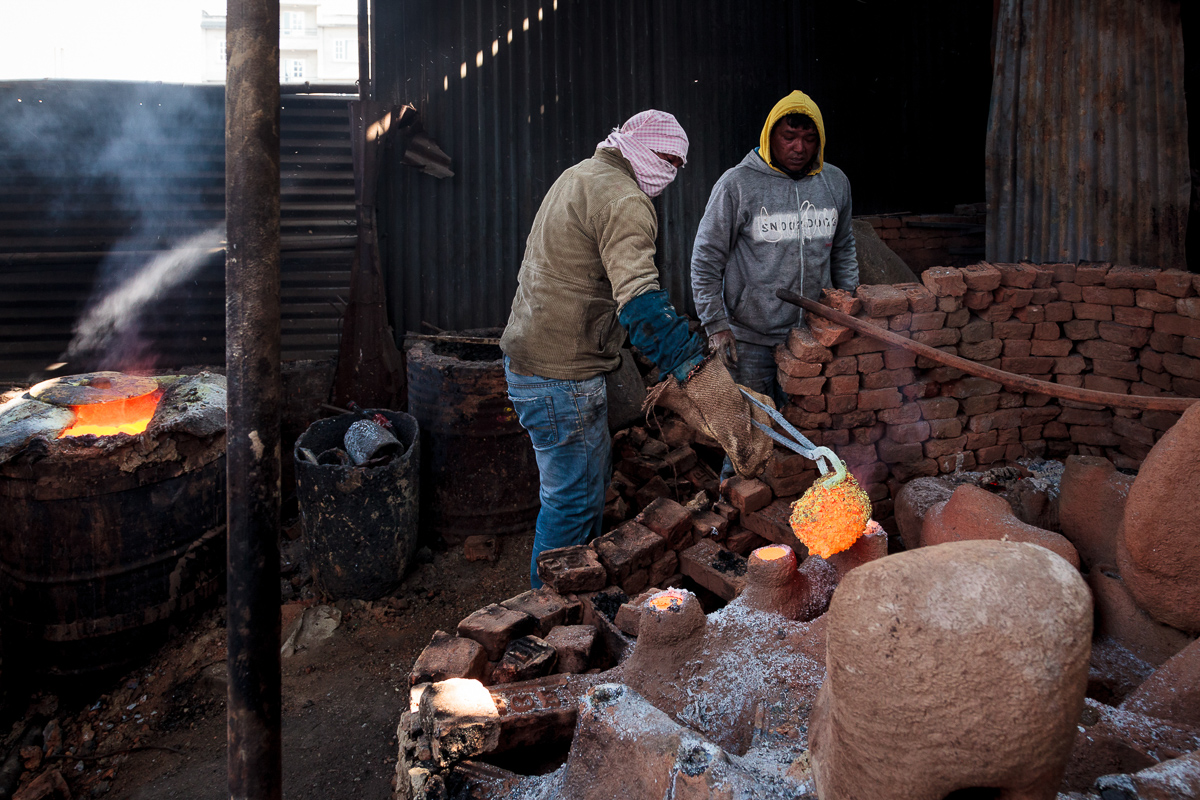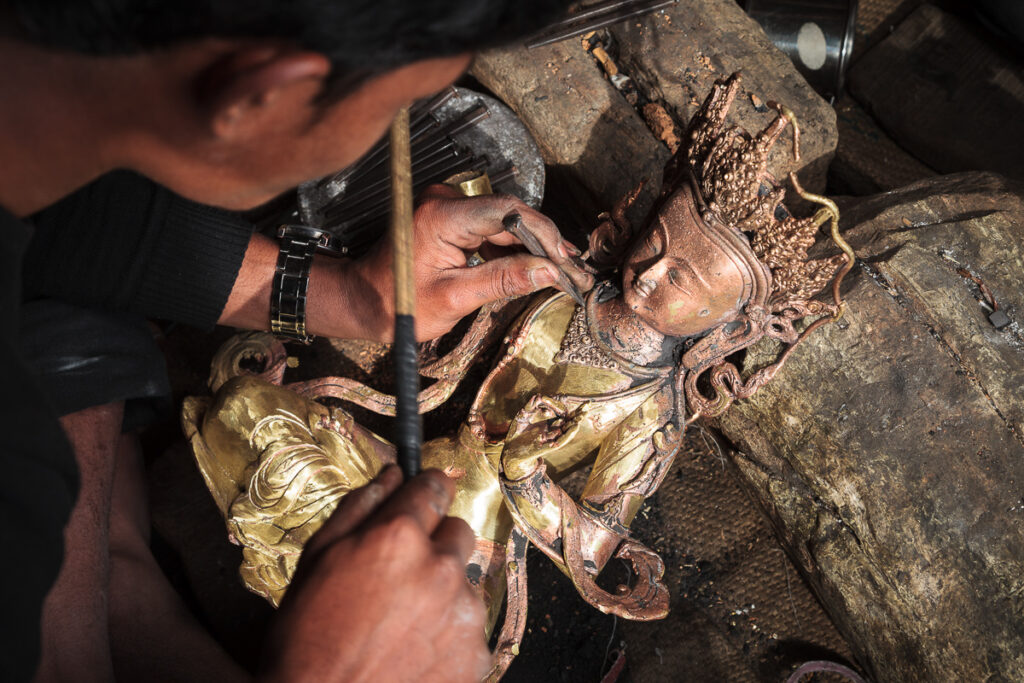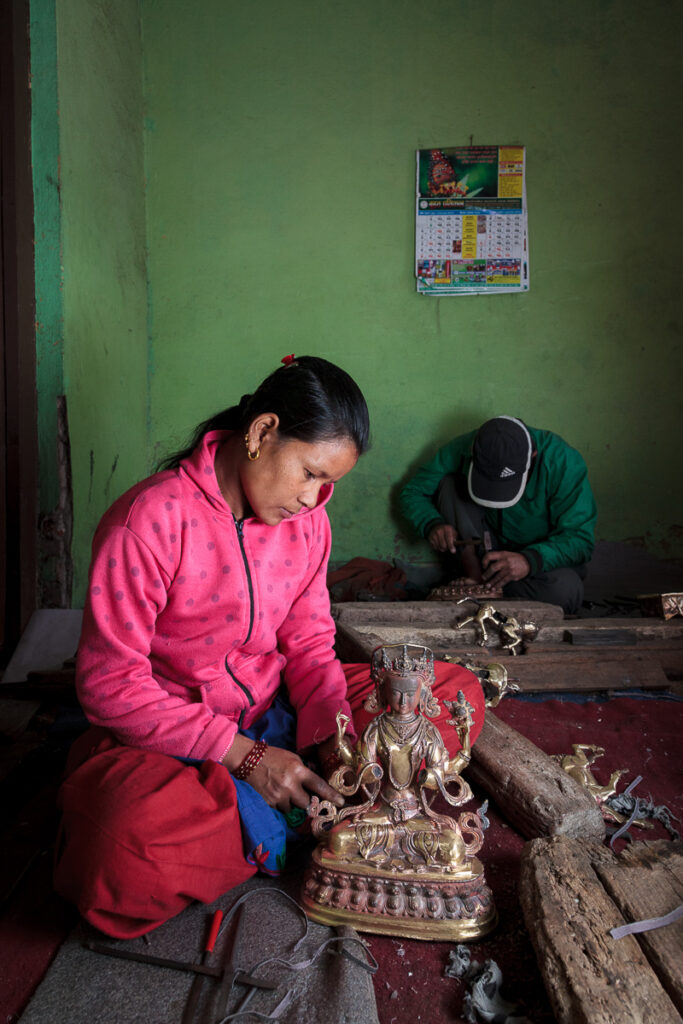Gary Wornell spends an intense day in a Kathmandu bronze-casting workshop, witnessing the impressive resilience of Nepali artisans.
It’s 4:00 am and under the thick blanket on my bed, I can hear sounds coming from the yard below my window. These January days start cold. It’s pitch black outside and I can see my breath as I shuffle into my jeans and head for the bathroom across the hall. The house is waking and Pradiip Maharjan is already up and has disappeared down the stairs to start the fires. Today he is casting copper—months of delicate wax carvings buried underneath clay and cow dung moulds—strange shapes that bear little relation to the forms inside.
Outside I find Pradiip and another worker crouched at different ends of the rough brick kiln. The top is open; flames are starting to lick against the inside walls from the fires underneath. All around the base long wooden planks are sticking out of the fireboxes and a bright orange glow is crackling as the heat intensifies. I ask him if all is going well and he nods and smiles. Smoke rises above the kiln, drifts up to the high corrugated iron roof and drifts into the Kathmandu morning sky. The sun is rising and the dogs are barking.
Pradiip’s wife comes out with a flask of hot spicy milk tea and deep-fried Sel roti—an oily doughnut-shaped rice flour sweet. We drink together and talk about the day ahead. The yard is busy with workers starting their chores; some are here for the casting, some to tend the fires and one man, the metal expert, is in charge of mixing the metals melting in the furnace.
Pradiip has been creating these statues for 15 years—six of those in this house he built himself. He started this work because he knew he could develop the skills to make the sculptures and the profession had a good reputation for making money. His first year was a real challenge though and he even considered changing profession at some point, but didn’t want to waste a year of his time so he took additional training and improved his skills.
He has a team of craftspeople working in different studios around the Kathmandu valley engaged in various stages of production. He makes the works only by commission: people send photographs of existing sculptures or pictures of old thangkas and specify the size and finish they want. From these two-dimensional images, Pradiip and his workers create full-scale clay models following the precise shape and proportions of the ancient figures. Fibreglass moulds are then created from the clay forms and from these the hot wax components are made before being assembled. The larger works can take up to five months from the modelling of the clay to the delivery of the completed piece, involving around 15 craft workers from start to finish.
Inside the house, there is the smell of burning paraffin as his workers heat iron tools to melt the pieces together. Two craftsmen sit by the gas burner in front of a pot of melting wax. Dozens of formed objects surround them; heads, lotus leaves, body parts ready for assembly. On the floor, there is a large Buddha covered in fine ornamentation and a worker is applying a bracelet to the upper arm with a hot iron. The dark brown material glistens as it melts, then cools as the armband is held in place. Motifs are added piece by piece to the form. A work this size can take several months before it is ready for casting.
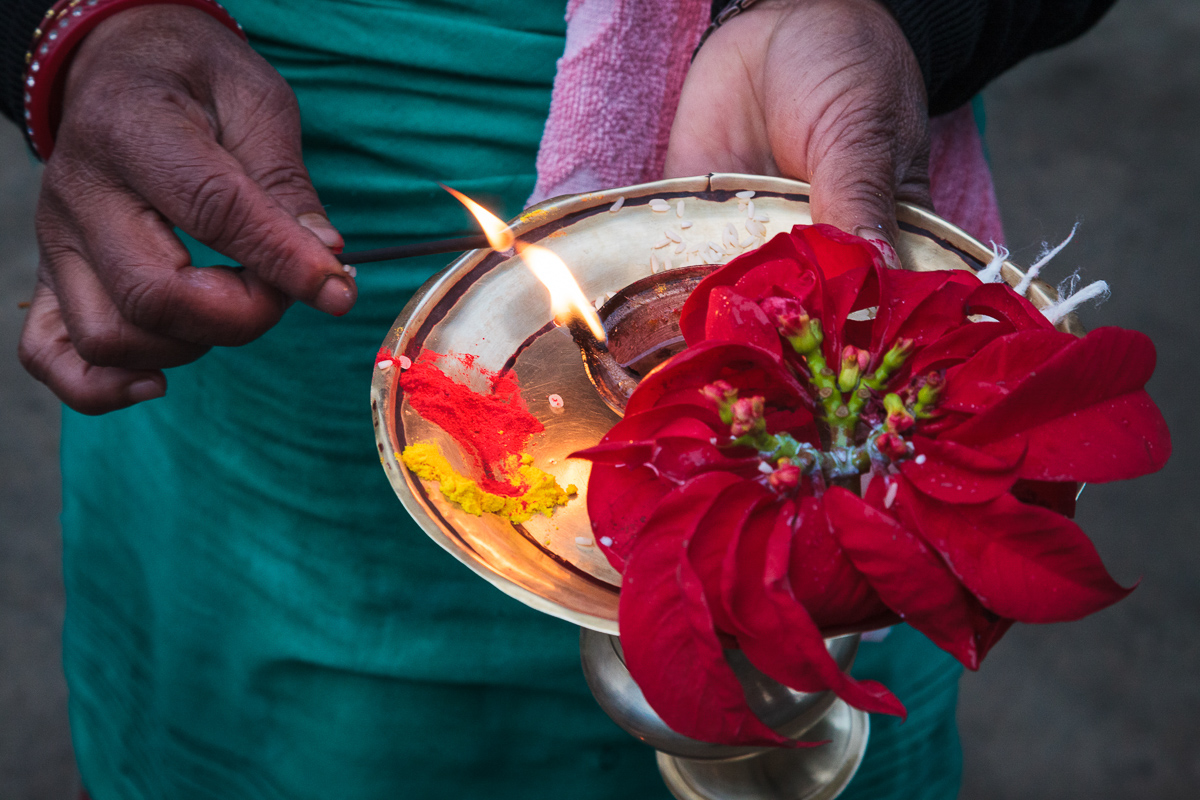
Pradiip’s mother holds an offering to the gods with a candle, red Poinsettia leaves, and some red and yellow powder.
Outside in the yard, I see Pradiip’s mother come from the house; a small dish in her hand with a candle, red Poinsettia leaves, and some red and yellow powder—an offering to the gods to bless the casting of these religious works. The ground is blessed, the wood used for firing is blessed and so too is the kiln. She walks around the yard, goes over to the kiln and as Pradiip stokes the fire she places a few leaves on the corrugated tin sheets that have been placed over the flames and blesses the coming day’s work.
By 7am the fire is raging. The bright red moulds are smoking as the wax melts inside.
By 7am the fire is raging. The bright red moulds are smoking as the wax melts inside. At small outlets at the base, the molten material is pouring into pots for recycling. The man in charge of the metal mixture is weighing recycled copper wires and new zinc blocks and soon the oil burner is started up, throwing intense flames into the base of the firebox with a roar. Pradiip tells me that this man is a specialist. Few people know the art, for mixing the metal to get the best cast is a highly skilled profession, and he travels from one workshop to another around Kathmandu doing just this. The noise of the burner is deafening, and flames shoot up out of the top of the furnace high into the air. The heat from both fires is intense, making it difficult to take photographs. By noon the casting had begun.
The smaller moulds are removed from the kiln with steel tongs immediately followed by the hot metal poured into the feed tubes protruding from the tops. It’s impossible for me to stand anywhere near and from a distance, I take my shots through the haze of smoke and fire. It reminds me of my days making ceramics. The alchemy of fire is intoxicating. Limestone powder is sprinkled into the moulds to keep the metal molten longer and as the liquid finds its way into the channels the metal is topped up and finally left to cool. Pradiip and another worker, their faces covered with rags to protect them from the intense heat, continue with each mould. The larger ones are too heavy to lift and are filled from inside the kiln. By early afternoon over 600 kilos of metal have been poured and the casting is done.
Pradiip’s father works busily in another corner of the yard away from the heat of the fires. The cooling moulds are drenched with water. Steam hisses against the burnt clay and fogs the scene. The charred casings are finally chipped away to reveal the clean metal underneath. I watch the bodies of the gods reveal themselves as the shards of clay fall away—metal feed tubes poking from their arms and bodies like strange umbilical cords.
I spent many days with Pradiip and his family over the months I lived in Kathmandu. We travelled around the valley together, sometimes spending a weekend walking high up in the hills to the northeast of the city, a two-day trek through old villages and forests to Chisapani and back again to the city.
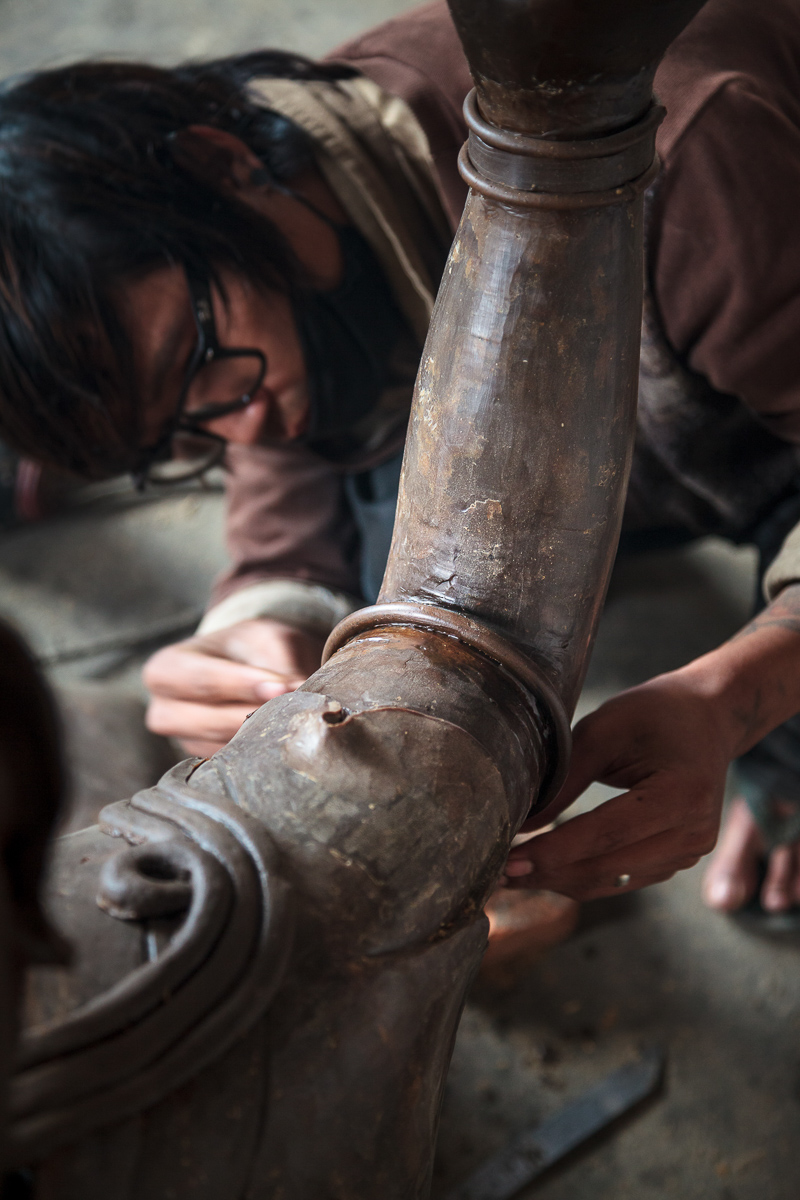
An armband is applied to a wax model of Mañjusri by a craftsman at Pradiip’s Stupa Handicrafts workshop.
One day we travelled down in the valley to the town of Bungamati where his teams of carvers work on the castings. There against a backdrop of rice fields and scattered houses stands a small two-story dwelling, the ground floor open to the street. The sound of metal hammering against metal is accompanied by the rhythmic scraping sound of emery paper smoothing out the bright copper forms. When the sculptures are brought here from his Patan factory, the copper feed tubes are cut from the forms before being handed over for welding. It is the welder’s job to patch up the holes and attach the hands to the bodies before the carvers begin to refine the surfaces. It can take three days for one person to refine an 18-inch statue from welding and sanding, to the time when the piece is ready for polishing.
In one room six or seven men and women were sitting on straw mats working in the bright sunlight, chatting above the racket, amused by my presence and laughing together as they worked. Sculptures in various stages of completion lined the walls, along with a few empty bottles and old rice sacks. There was a family atmosphere in this house where men and women worked together, their children wandering in and out watching me work, talking or playing with their parents during lunch.
Strips of sandpaper were drawn across the pitted surfaces until the burnt metal shone brightly underneath. The carvers worked with thin steel tools and small hammers. They engraved details into the fine decoration, picking out beads and jewellery or carving from memory the traditional patterns on folds in the clothing. Two women worked on small statues, occasionally getting up from their mats to tend to their children or make tea.
The welder, brought in from outside, worked in the other room alone, gas torch hissing loudly in his hand as he turned the pieces over and over, lifting his protective goggles now and then before continuing. Like the fireman in charge of the casting metal, he is in regular demand and travels around the country for months on end before returning to his home in India.
As the rest of the city rushes home in the evening, the workshops dependent on electricity make use of the intermittent supply for their power tools.
When the works leave the carvers they are taken back to Patan where they are polished, buffed and prepared for gilding. As the rest of the city rushes home in the evening, the workshops dependent on electricity make use of the intermittent supply for their power tools. Power cuts and load shedding are so common and irregular that the factories have to work whenever the supply returns. The factory Pradiip uses is down a narrow passage, not far from his own workshop off a main road on the south side of Patan. Access is down narrow steps, into a muddy lane and through an unmarked metal gate. If you hadn’t been there before it would be impossible to find.
- A craftsman uses a small hammer and chisel to carve fine detail into the copper casting.
- A craftswoman sands a copper casting at a workshop in Bungamati.
- A wax model being created of Mañjusri, the oldest and most significant bodhisattva in Mahayana literature.
- A deity lies on the floor cooling after the clay mould has been broken away.
From the outside, the building looks like a cowshed, which it probably was at some point, roughly thrown together with sheet metal and brick walls. One very dim fluorescent light barely throws enough illumination into the room to see to the other end and I wondered just how difficult it must be for these workers to see what they are doing. It is hard to imagine that the final destination of the sculptures scattered about on the floor inside will be a monastery or temple when you see the rough journey they have taken from wax casting to this point.

A craftman talks on his mobile with a large Buddha cast in copper ready for polishing. Patan, Kathmandu
Inside the dimly lit room, the body of a large copper Buddha sits headless in the lotus position. The creation of the heads seems to be a special art of its own, and on the larger figures, these are often welded in place when most of the other work is done. You can always weld a hand back on and attach a broken piece of clothing, but the head is the thing that the client examines first and its expression and quality determine the value of the piece as a whole.
The man in charge of buffing was on his mobile when I arrived. His leather jacket echoed the clothing on the headless Buddha in front of me and even the colour was the same. A giant single-phase electric motor attached to a plank of wood was strung from the ceiling on a chain and pulley and draped lazily across the knee of the Buddha. Piles of smaller sculptures stacked in loose pyramids filled the floor space and against one wall Buddhas lay face down in murky green acid tubs, their backs glistening in the fluorescent lights from above. Crouched on the floor beside the figure the worker raised the machine on the pulley as his assistant applied buffing compound to the spinning cloth wheel, working his way across the torso in broad heavy strokes and the copper began to shine.
Hardship is something Nepalis take in their stride. After the earthquakes of 2015 little had changed for Pradiip. Everything stopped for several months and fuel and material shortages throughout the country created problems for everyone. But slowly things returned to normal, as they have again during the pandemic and Pradiip continues to create some of his most ambitious works of his career including a recently completed, twenty-five foot statue, which took more than two years to complete.
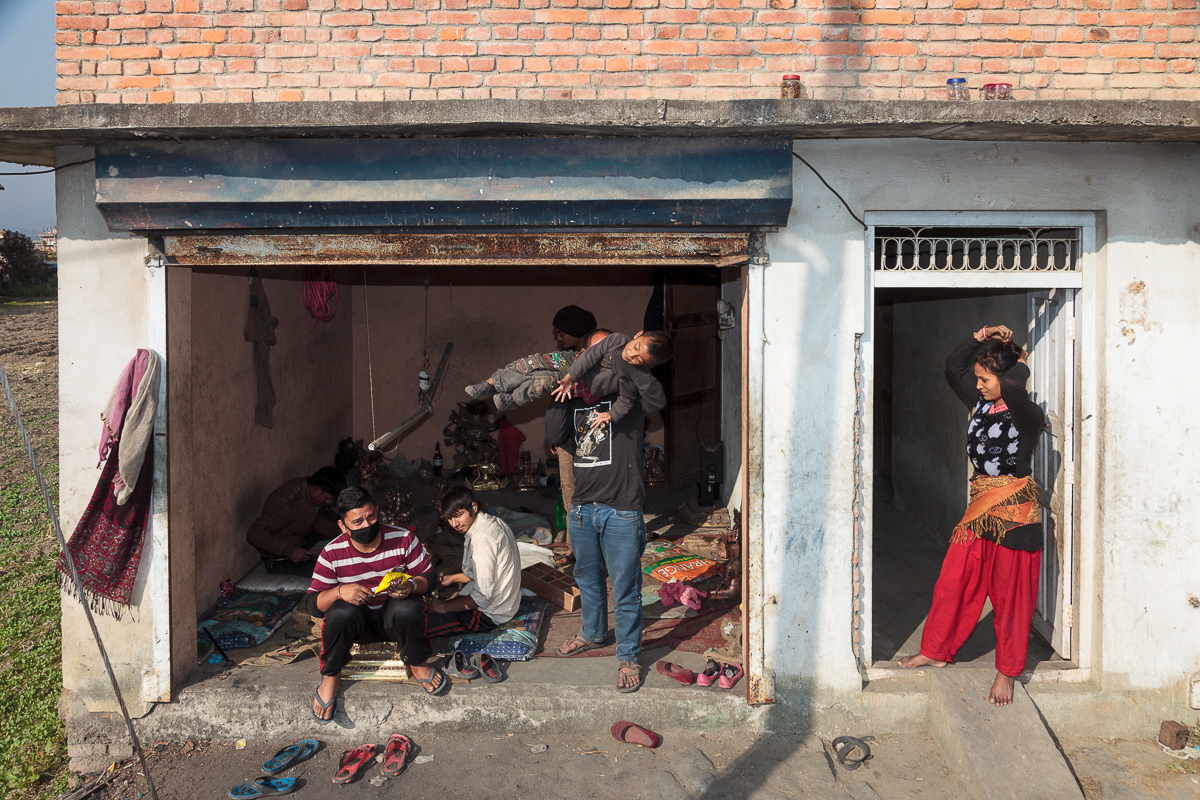
A team of carvers and finishers take a break in the afternoon sun with family from their working day.
Text and photography by Gary Wornell
About Gary Wornell
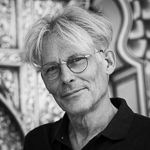 Gary Wornell is an artist, photographer, film-maker, master print-maker, photojournalist, author and independent curator. A Canadian citizen, Gary has lived for extensive periods in the UK, Finland and Nepal. He divides his time between Finland and Nepal. In the last three years, he has worked as OECD-Finland-EU Social Protection Systems mobile device video trainer in Kyrgyzstan, Ethiopia, Cambodia and Zambia. He is currently active as design and marketing consultant to the Nepal infant clothing enterprise – Kokroma.com setting up their online shop, social media presence and developing production tools and methods for the clothing brand’s workshop in Kathmandu. He is book designer, photographer and author of Treasure of Nepal, Maahenki Finland 2016 – ISBN-10 9523010824 and designer Co-Author of Crafting a New Future for Nepal’s Traditional Artisans, PAF-The World Bank Group 2018 ISBN-9789937036511.
Gary Wornell is an artist, photographer, film-maker, master print-maker, photojournalist, author and independent curator. A Canadian citizen, Gary has lived for extensive periods in the UK, Finland and Nepal. He divides his time between Finland and Nepal. In the last three years, he has worked as OECD-Finland-EU Social Protection Systems mobile device video trainer in Kyrgyzstan, Ethiopia, Cambodia and Zambia. He is currently active as design and marketing consultant to the Nepal infant clothing enterprise – Kokroma.com setting up their online shop, social media presence and developing production tools and methods for the clothing brand’s workshop in Kathmandu. He is book designer, photographer and author of Treasure of Nepal, Maahenki Finland 2016 – ISBN-10 9523010824 and designer Co-Author of Crafting a New Future for Nepal’s Traditional Artisans, PAF-The World Bank Group 2018 ISBN-9789937036511.

